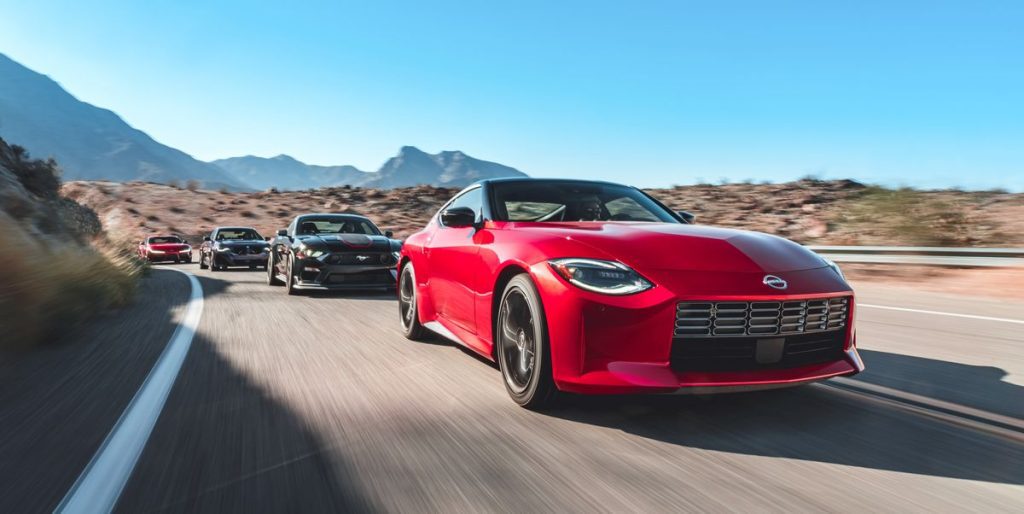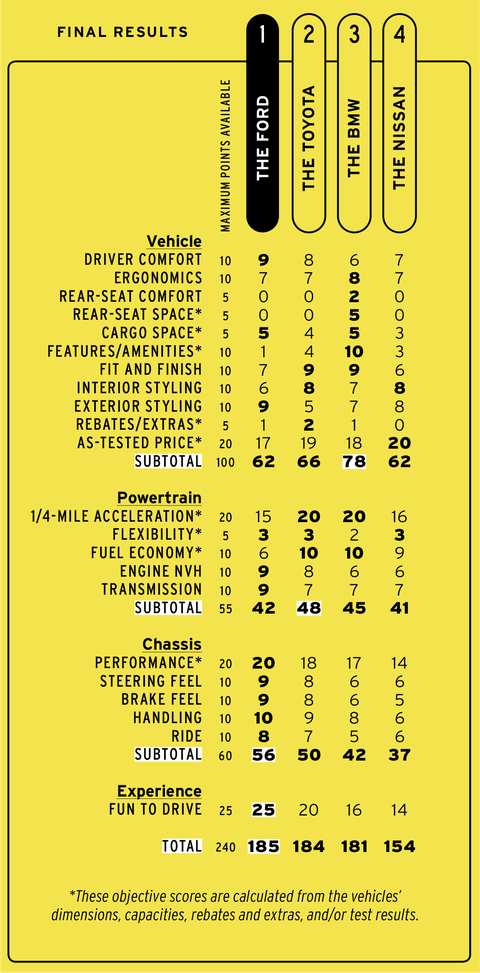Comparison Test: 2022 BMW M240i vs. 2021 Ford Mustang Mach 1 vs. 2023 Nissan Z vs. 2022 Toyota GR Supra 3.0

From the July/August 2022 issue of Car and Driver.
We’d like to help you have more fun. If you have $60,000 to spend on a performance car, you’re clearly looking to smile more. This comparison test is designed to find what sparks joy. Fortunately, the performance cars at this price point are all grin machines.
The Nissan Z is the newest entertainer in the segment, and its launch is one of the most anticipated of the year. In addition to its 400-hp twin-turbo V-6, manual gearbox, and tidy size, the Z is priced right. A 2023 Nissan Z Performance starts at $51,015 without options, which are limited to paint and a few skippable trifles. Our Passion Red test car sits at $53,610.
Marc UrbanoCar and Driver
Toyota’s GR Supra is the Z’s most obvious competitor. The Supra 3.0 comes with a 382-hp turbocharged 3.0‑liter inline-six, which makes an excellent foil for the Z’s same-size V-6. Right now the Supra comes only with an automatic—a manual is on the way—which gives the Z an advantage because a manual will always be more fun. The Supra 3.0 Premium we wrangled for this test starts at $56,065, with our test car’s price rising to $57,260 owing to its lone option, the Driver Assistance package.
BMW’s M240i xDrive isn’t a two-seat sports car, but it’s here because it has the Supra’s 382-hp heart planted in a coupe with a back seat and trunk. A slightly more practical alternative to the Z and Supra, the M240i also comes standard with all-wheel drive, ensuring idiot-proof acceleration. A $49,545 base price undercuts the Z Performance, but our M240i ran all the way up to $59,270 with options. Only about $2400 of that extra outlay is relevant to performance, though.
Marc UrbanoCar and Driver
And because we opened the comparison test to cars with rear seats, we thought it right to include a Ford Mustang, specifically the track-focused Mach 1. The price and performance line up with the rest of the group, although a 2022 model was unavailable to us, which left us with a ’21 test car. Our 2021 Mach 1 carries a base price of $54,595, which rose to $60,740 with options (including rear-seat delete), the most expensive and consequential of which is the $3750 Handling package. A 2022 Mach 1 will run you $57,665, or $64,570 when equipped like our test car. Other changes include a slight drop in horsepower, from 480 to 470.
With the four contenders selected, we headed for the hills, connecting our favorite Southern California back roads in a massive loop spread across five counties. After solidifying our subjective impressions, we descended to the test track to see how they performed there.
Marc UrbanoCar and Driver
4th Place:
2023 Nissan Z Performance
Highs: Lowest as-tested price, Z heritage styling largely works inside and out, six-speed manual transmission.
Lows: Needs more aggressive tires, underdamped suspension feels like it’s up on tiptoes, carries over a lot from the old 370Z.
Verdict: If Nissan doesn’t release a NISMO version, the Z’s fate may fall to the aftermarket.
We know. We hated to write that as much as you’re disappointed to read it. One of the most oft-repeated mutterings during this test went something like “I wanted to like it more than I did.” Our initial brief encounter with the Z at the launch event showed promise, but in this longer fight against direct and tangential rivals on roads of our own choosing, the long-awaited Z fell to the back of the pack. At first glance it captures the value and performance of the original Z quite well, but nothing brings flaws to light like several days of driving the competition.
On the road, the Z’s twin-turbo V-6 drew consistently positive comments. It pulled hard and left us smiling. Only the dull and Pathfinder-esque engine sound and somewhat indistinct shifter feel generated any notebook gripes. In testing, the Z found itself in a limp-home mode despite extra cool-down passes and a couple of restarts. Running the 91 octane that’s the best available in California, the Z proved slower than its 400 horses would suggest. A 4.5-second run to 60 mph and a 13.0-second quarter-mile are almost a second behind the Supra and the M240i.
Marc UrbanoCar and Driver
The Z’s interior cleverly blends modern screens with throwback elements like dashtop gauge pods and a manual shifter.
The problems were likely due to our Z tester’s pre-production status. Our hurry to compare the Z meant that we couldn’t get a full-fledged production car. Nissan does admit that the V-6’s peak power corresponds to 93 octane fuel. We borrowed another pre-production Z for a follow-up test in Michigan on the local 93 brew, and times fell to 4.1 seconds to 60 mph and 12.6 seconds in the quarter-mile. Those times still trail the Supra’s 91-octane numbers by 0.4 second.
It wasn’t just the engine that seemed out of step—the warmed-over 370Z chassis struggles to keep up with the rest of the group. It behaves eagerly when the car is driven modestly, and the suspension has long-travel action that handles rumpled pavement effectively. But understeer rears its head when you push the Bridgestone S007 B-Silent tires, and that chassis gets a bit sloppy because the damping can’t quite keep the car settled when you’re steaming through corners or braking hard on uneven pavement. A more aggressive tire would likely up the 0.93 g of lateral grip and shorten the 166-foot 70-mph stops.

Car and Driver
The driving position earned praise, but the 370Z-derived seats themselves pleased no one, especially since the fore-and-aft controls again are on the transmission-tunnel side. Tall drivers following short ones had to duck in to grind the seat rearward before they could climb aboard.
After driving the car over several days, we realized that the newest Z isn’t quite the apex of the segment. But with stickier tires and the engine-management issues of our pre-production car sorted, we think the Z could have a better shot.
Marc UrbanoCar and Driver
3rd Place:
2022 BMW M240i xDrive
Highs: Impressively quick, flexible interior, lowest base price.
Lows: Small seats are hard, overdamped suspension, no manual.
Verdict: The best everyday car here is too stiff for its own good.
We’re big fans of the M240i xDrive, and this third-place finish hasn’t changed that. It is by far the most practical sporting machine here, with its trunk and back seat (the latter of which folds to expand the former), as well as the inherent acceleration advantage of all-wheel drive. It also sports the lowest starting price of the group, though a slew of options ballooned the number to second highest.
Remember when BMW gauges were easy to read? Despite the M240i’s portly 3864-pound curb weight, its all-wheel-drive system helped it hit 60 in 3.6 seconds.
It’s quick, thanks to a healthy 382-hp turbocharged inline-six and an eight-speed automatic that work brilliantly together. The superior launch traction of xDrive is the ace in the hole shot, and it gave the BMW an initial start-line lead it never relinquished on the way to a 3.6-second 60-mph run and a 12.1-second quarter-mile. But anyone who’s ever driven all-wheel drive in snow will tell you it means little when it comes to turning and braking. And so it was at the track, where the M240i’s highest-in-test mass (3864 pounds) and relatively narrow rubber led to a 0.98-g skidpad performance and a 70-mph stop of 153 feet. Respectable numbers, but only good for third in this group.
Marc UrbanoCar and Driver
On the wild back roads of California, no one called out the BMW for lacking grip or braking prowess. We pushed it hard on any number of challenging roads, and it proved tenacious. Its front end will break free slightly earlier than the Supra’s, but the bigger issue is the stiffness of the suspension, particularly the damping. The M240i feels harsh and overdamped outside a smooth racetrack and a little unsettled by rough pavement in the canyons. It never relaxes and takes a breath. You get the feeling it might twitch sideways at the wrong moment, even though it never does.

The seats don’t help. The upper reaches of the backrest are flat, and the taller folks among us were hanging on to the steering wheel for lateral support. While the bolsters are adjustable, there’s nothing in the shoulder area to work with. They’re also ropey and firm, which gets tiring after a long day in the saddle and does little to filter out any of the road imperfections coming up through the suspension. A better seat and more suspension compliance would help the quickest car here be more in tune with its incredible acceleration.
Marc UrbanoCar and Driver
2nd Place:
2022 Toyota GR Supra 3.0 Premium
Highs: Quick in a straight line, balanced handling and braking, steering has more life than the true BMW.
Lows: Claustrophobic cabin, highest base price, no manual (yet).
Verdict: A well-rounded sports car.
As you drive the Supra, great memories return. It starts with the cockpit itself, which is refreshingly simple considering its BMW roots. The driving position is spot-on, and the tachometer sits front and center with physical numbers rimming a virtual needle. The biggest drawback is the sloping roofline, which makes the cockpit feel confining, like you have the sun visors placed over the side glass. You need to duck down to say hi at the Taco Bell drive-through (unless you want to hide your face).
The Supra’s cabin answers this burning question: What if the interiors of the Toyota GR86 and BMW Z4 had a baby?
The Supra shares its powertrain with the M240i, except its 3.15:1 final-drive ratio is shorter than the 2.81 gears in the BMW. At 3382 pounds, it’s also some 482 pounds lighter than the M240i. It likewise benefits from a 97.2-inch wheelbase that’s 10.7 inches shorter and wider tires front and rear. Despite driving only the rear wheels, the Supra hit 60 mph, 100 mph, and the quarter-mile a mere tenth of a second behind the M240i. Speedy at the track and on the back roads, it is, in ornithological terms, a hoot.
Marc UrbanoCar and Driver
Push hard and you’ll find a true sports car. The front end digs in on corner entry, and the short wheelbase helps the rear pivot with no hesitation. Lifting the throttle while cornering tightens the arc, but there’s little chance of the rear end taking over. Somehow the steering feels more communicative here than in the BMW, making the limit easier to anticipate before you cross it. The track results follow along, with a tidy 1.00 g on the skidpad and a 147-foot stop from 70 mph.

Car and Driver
On the open road, the Supra’s suspension is everything the M240i’s isn’t—reasonably compliant, properly damped, easy to live with all day. Sure, coarse roads will coax road noise from the tires (which are the same size as the Z’s), but the strikes go into a structure that never shimmies or crashes. This is a sports car for the daily grind. Now please hurry up with that manual, Toyota.
Marc UrbanoCar and Driver
1st Place:
2021 Ford Mustang Mach 1
Highs: Intoxicating engine note, massive buckets of grip, comfy Recaros hold on tight.
Lows: Not a drag-strip hero, abysmal fuel economy, rental-Mustang interior.
Verdict: Endless joy on a winding road—or in a tunnel.
The Mach 1 won enough hearts to take the W. It earned all the fun-to-drive points, but not every ballot gave it the top spot. A close look at the tally shows that the Mach 1 had a lopsided score card, with higher highs offsetting some lower lows. That kind of love-hate sentiment makes cars memorable. Or at least debatable.
A lot of the Mach 1’s flavor comes from the Handling package, which adds 305/30R-19 front and 315/30R-19 rear Michelin Pilot Sport Cup 2 tires (the wildest and widest in the group), a revised suspension calibration, and spoilers on top of spoilers for extra downforce. Those wide tires tend to get distracted by parallel seams when running straight, but the steering was resolutely spot-on and talkative on every bit of the circuitous back roads we traversed. Go hard and the Mustang enjoys monstrous grip and uncanny stability.
Marc UrbanoCar and Driver
The Mach 1’s cue-ball shift knob bolts to the slick Tremec TR-3160 manual instead of the Mustang GT’s Getrag six-speed.
The classic sound of the Mustang’s 480-hp 5.0-liter V-8 reverberates off canyons, tunnels, brick walls, and the inside of your skull. Go ahead, enjoy an unnecessary downshift and a superfluous throttle blip; we won’t judge. We all loved the cue-ball shifter and the unbeatable six-speed manual gearbox, even if the taller drivers among us felt like we were throwing an elbow into the passenger’s seat on the five-six upshift. Sure, you can commit the sacrilege of fitting a 10-speed automatic if you must, but, frankly, you must not. Not here.
Admittedly, the manual takes a bite out of the stonking V-8’s acceleration performance. The Mustang returned the slowest times of the bunch, in fact, tying the Z at 4.5 seconds to 60 mph, while lagging a tenth behind at 13.1 seconds in the quarter-mile. Previous testing in Michigan (4.3 seconds to 60, 12.6 quarter-mile) could indicate an allergy to 91 octane, as Ford also claims peak power on 93. The wide and sticky rubber practically carved grooves in the skidpad to the tune of 1.06 g’s, and the Ford ruled the braking tests with a 138-foot stop from 70 mph. Clearly, this iteration of the Mustang is set up for corners and circuits, not drag strips.
We’re not ashamed to admit we left the rev-match feature engaged much of the time, not least because it’s a pain to toggle on and off. Other controls in the interior are much easier to decode and use, even if the presentation inside looks dated because of this design’s age and rental-car materials budget. Pay a little extra for the optional Recaro buckets—once in, you’re bolted in place and comfortable.

The Mach 1’s over-the-top attitude and handling are undeniable. Even the voters who gave the Supra the win had to admit the Mach 1 offers more smiles per mile. It might suck gas, have an interior by Avis, and lack the acceleration of some competitors, but this is the most fun you can have for about $60,000.


A car-lover’s community for ultimate access & unrivaled experiences. JOIN NOW
This content is created and maintained by a third party, and imported onto this page to help users provide their email addresses. You may be able to find more information about this and similar content at piano.io




